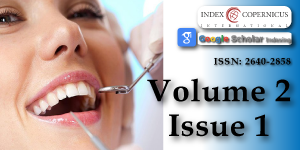How Condylar modifications occurs
Main Article Content
Article Details
Copyright (c) 2018 Kulshrestha R.

This work is licensed under a Creative Commons Attribution 4.0 International License.
Pancherz H. The Herbst appliance—its biologic effects and clinical use. Am J Orthod. 1985; 87: 1–20. Ref.: https://goo.gl/boQL1t
Rabie AB, She TT, Ha¨gg U. Functional appliance therapy accelerates and enhances condylar growth. Am J Orthod Dentofacial Orthop. 2003; 123: 40–88. Ref.: https://goo.gl/A7gp9w
Rabie AB, Xiong H, Ha¨gg U. Forward mandibular positioning enhances condylar adaptation in adult rats. Eur J Orthod. 2004; 26: 353–358. Ref.: https://goo.gl/cAaTX8
Shen G, Rabie AB, Zhao ZH, Kaluarachchi K. Forward deviation of the mandibular condyle enhances endochondral ossification of condylar cartilage indicated by increased expression of type X collagen. Arch Oral Biol. 2006;51: 315–324. Ref.: https://goo.gl/eJnphG
Fuentes MA, Opperman LA, Buschang P, Bellinger LL, Carlson DS, et al. Lateral functional shift of the mandible: Part II. Effects on gene expression in condylar cartilage. Am J Orthod Dentofacial Orthop. 2003; 123: 160–166. Ref.: https://goo.gl/WPjfq2
Woodside DG, Metaxas A, Altuna G. The influence of functional appliance therapy on glenoid fossa remodeling. Am J Orthod Dentofacial Orthop. 1987; 92: 181–198. Ref.: https://goo.gl/mXkCJ8
Hinton RJ, McNamara JA Jr. Temporal bone adaptations in response to protrusive function in juvenile and young adult rhesus monkeys (Macaca mulatta). Eur J Orthod. 1984; 6: 155–174. Ref.: https://goo.gl/9J3LiF
Rabie AB, Zhao Z, Shen G, Ha¨gg EU, Dr O, et al. Osteogenesis in the glenoid fossa in response to mandibular advancement. Am J Orthod Dentofacial Orthop. 2001;1 19: 390–400. Ref.: https://goo.gl/898yhG
Bergman RA, Afifi AK, Heidger PM. Histology. Philadelphia, Pa: WB Saunders; 1996.
Shen G, Darendeliler MA. The adaptive remodeling of condylar cartilage—a transition from chondrogenesis to osteogenesis. J Dent Res. 2005; 84: 691–699. Ref.: https://goo.gl/UUmNdR

